Growing tomatoes can be very rewarding. Enjoying a fresh, juicy harvest is a great feeling. But, the first steps are key to success. Planting tomatoes at the right depth is essential for a strong root system.
Planting tomatoes too shallow can harm the roots. This makes the plants weak and leggy. But, planting them too deep can rot the stem. The perfect depth helps the roots grow strong, supporting the plant.
Key Takeaways
- Planting tomatoes at the right depth is crucial for healthy plants.
- A strong root system leads to a bountiful harvest.
- Avoid planting tomatoes too shallow or too deep.
- The ideal planting depth supports robust root development.
- Healthy plants result from proper planting techniques.
Understanding Why Planting Depth Matters for Tomatoes
Getting your tomato plants off to a good start is all about planting depth. The right depth is key for their growth. It affects their roots and overall health.
Tomato roots can grow deep, up to three feet. But, this can change based on the tomato type and growing conditions. The depth you plant them in impacts their root growth. Planting too shallow can make the plants weak and leggy. Planting too deep can rot the stem and kill the plant.
The Science Behind Tomato Root Development
Tomato plants have two kinds of roots: taproots and adventitious roots. Taproots grow straight down, while adventitious roots form along the stem. Proper planting depth helps develop a strong root system. This is vital for a healthy plant.
Impact of Planting Depth on Plant Health
Planting depth affects tomato plant health. Correct planting leads to strong stems and robust roots. This makes plants more resistant to diseases and pests. Gardening experts say, “Tomato plants need space for better airflow. This keeps leaves dry and fights off diseases.” Proper spacing and depth are crucial for healthy plants.
Benefits of Proper Depth Planning
Proper depth planning has many benefits. It improves plant stability, nutrient uptake, and stress resistance. Planting tomatoes at the right depth promotes healthy growth and high yields. It’s a simple yet effective way to ensure your tomato plants thrive.
“Planting tomatoes at the correct depth is a fundamental aspect of gardening that can significantly impact the success of your crop.”
Understanding and applying the correct planting depth is key for growing healthy tomatoes. By knowing the science behind root development and its impact on plant health, you can make better decisions. This will help you optimize your tomato planting depth.
How Deep to Plant Tomatoes: The Golden Rules
Planting tomatoes at the right depth is key to a good harvest. Knowing the golden rules of planting depth is crucial for your tomatoes to thrive.
Planting tomatoes involves a simple rule: bury half of the stem underground and keep the other half above ground. This method helps the plant grow strong roots. Strong roots are essential for the plant’s health and how well it grows.
For example, if your tomato plant is 12 inches tall, plant it 6 inches deep. This depth helps the stem grow more roots. These roots are important for taking in nutrients and water. The benefits of planting correctly include:
- Increased root development for better nutrient uptake
- Improved plant stability and resistance to wind
- Enhanced overall plant health and productivity
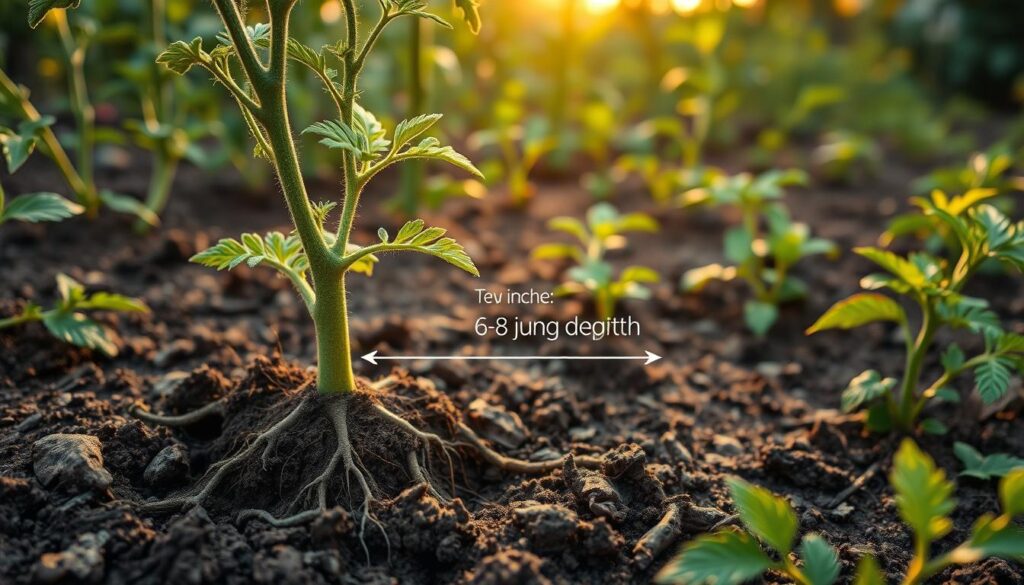
In short, planting tomatoes at the right depth is vital for their success. By burying half the stem, you help your tomatoes grow into healthy, productive plants.
Preparing Your Soil for Optimal Planting Depth
To get the best tomato planting depth, start with good soil. The soil type and drainage are key. Adjusting your soil can make a big difference for your tomatoes.
Soil Type Considerations
The soil in your garden matters a lot for tomato planting depth. Heavy clay soil needs better drainage to avoid waterlogging. Sandy soil might need organic matter to hold moisture.
Soil Texture and Tomato Roots: Soil texture impacts tomato root growth. Clay soils are dense and need organic matter. Sandy soils drain fast and may need more water.
Drainage Requirements
Good drainage is crucial for tomato health. Bad drainage can cause root rot. Mix in compost or manure to improve drainage.
- For clay soils, add compost to improve drainage and aeration.
- For sandy soils, incorporate well-rotted manure to retain moisture.
Soil Amendment Tips
Adding the right materials to your soil can make it better. Compost and manure are great for soil quality. They help roots grow strong.
| Soil Amendment | Benefits | Application Rate |
|---|---|---|
| Compost | Improves soil structure, increases fertility | 2-3 inches mixed into top 6-8 inches of soil |
| Well-Rotted Manure | Enhances soil fertility, improves moisture retention | 1-2 inches mixed into top 6-8 inches of soil |
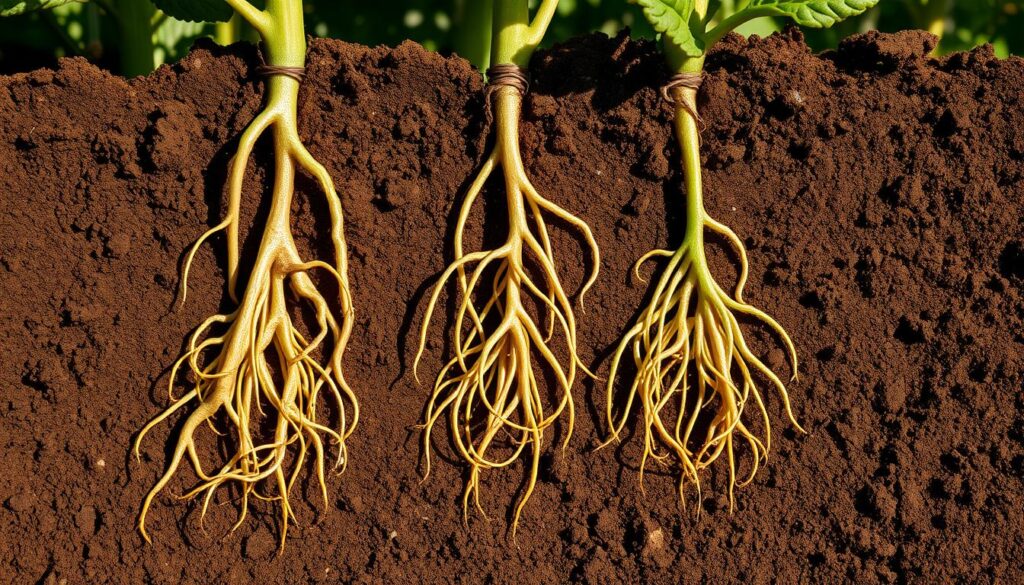
Think about your soil type, drainage, and amendments for the best tomato planting depth. This prep helps your tomatoes grow strong roots. It leads to healthier plants and a bigger harvest.
Planting Depth Guidelines for Tomato Seeds
The depth at which you plant your tomato seeds is very important. It affects how well they grow. Planting at the right depth helps your seeds germinate and grow into strong plants.
For the best results, tomato seeds should be planted 1/4 inch deep and 2-3 inches apart. This spacing lets them grow well without being too crowded. Keeping the soil moist during germination is also key.
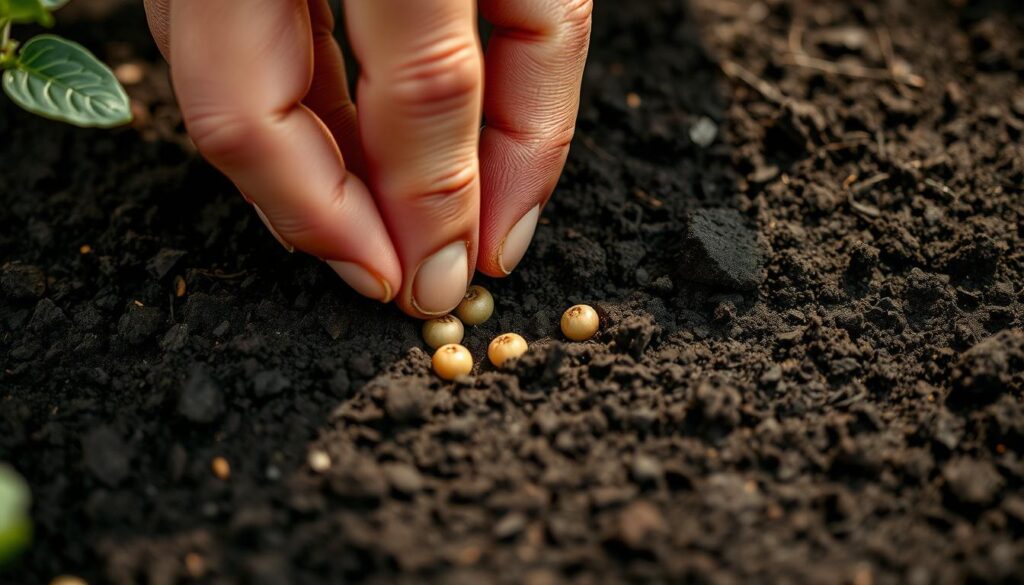
Gardening experts say, “Proper spacing and depth are key to a successful tomato harvest.” Planting your tomato seeds correctly is the first step to a great harvest.
| Planting Depth | Spacing | Soil Moisture |
|---|---|---|
| 1/4 inch | 2-3 inches | Consistently moist |
By following these guidelines, you can give your tomato seeds the best start. This leads to healthy plants and a productive harvest.
Transplant Depth Techniques for Established Plants
How deep you plant established tomato plants is key for their health. Doing it right can lead to stronger roots, healthier plants, and more fruit.
There are several ways to transplant tomato plants. Let’s look at each method closely.
Deep Planting Method
The deep planting method buries the tomato plant up to its first true leaves. This method helps the plant grow a stronger root system. It makes the plant more stable and productive.
Benefits of Deep Planting:
- Increased root development
- Improved plant stability
- Enhanced nutrient uptake
Trench Planting Approach
The trench planting method lays the tomato plant on its side in a trench. Then, it covers it with soil, leaving only the top leaves out. This method is good for leggy plants or those with disease.
Key Considerations:
- Ensure the soil is well-draining to prevent waterlogged conditions
- Remove any weak or diseased leaves before planting
- Water thoroughly after planting
Container Depth Requirements
When moving tomatoes to containers, the container’s depth matters. A deeper container lets roots grow more, making plants healthier.
| Container Depth | Root Development | Plant Health |
|---|---|---|
| Less than 12 inches | Limited root growth | Prone to nutrient deficiencies |
| 12-18 inches | Moderate root growth | Generally healthy |
| More than 18 inches | Extensive root growth | Robust and healthy |
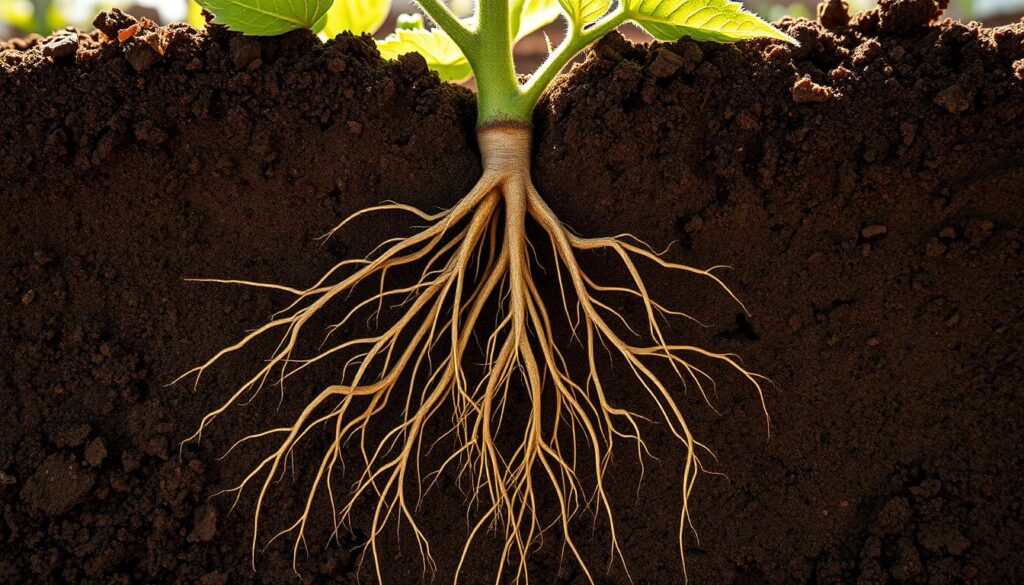
By using these transplant depth techniques, you can greatly improve your tomato plants’ health and yield.
How Deep Do Tomato Roots Grow in Different Conditions
Tomato roots can grow quite deep into the soil. But, their depth changes based on several factors. In the best conditions, tomato roots can reach up to 3 feet deep. This helps the plant get more nutrients and water.
The type of soil, its moisture, and temperature all play a big role. For example, in well-draining soils, tomato roots grow deeper. But, in heavy or waterlogged soils, they stay shallower.
Factors Affecting Tomato Root Depth
- Soil Type: Well-draining soils encourage deeper root growth.
- Moisture Content: Adequate moisture supports healthy root development.
- Temperature: Optimal temperatures facilitate root growth.
Knowing these factors helps you plan better. You can prepare the soil and plant at the right depth. This way, you can help your tomato plant grow strong and produce well.

Here’s a comparison of how different conditions affect tomato root depth:
| Condition | Root Depth |
|---|---|
| Well-draining soil | Up to 3 feet |
| Heavy or waterlogged soil | Less than 2 feet |
| Optimal temperature and moisture | 2-3 feet |
Adjusting your planting strategy based on root depth is key. It ensures your tomato plants get the nutrients and water they need for growth.
Common Depth-Related Problems and Solutions
Planting tomatoes too deep can cause many problems. It can make stems weak and leggy, or lead to rot and disease. It’s important to know the signs of planting too deep to fix the issue.
Signs of Improper Planting Depth
There are several signs that your tomato plants might be planted too deep. These include:
- Yellowing leaves, which can mean too much water or poor drainage.
- Soft, spindly stems that break easily, often from planting too shallow.
- Less fruit, which can be due to stress from the wrong planting depth.
Visual inspection of your plants is key. Look for these signs and adjust your planting technique if needed.
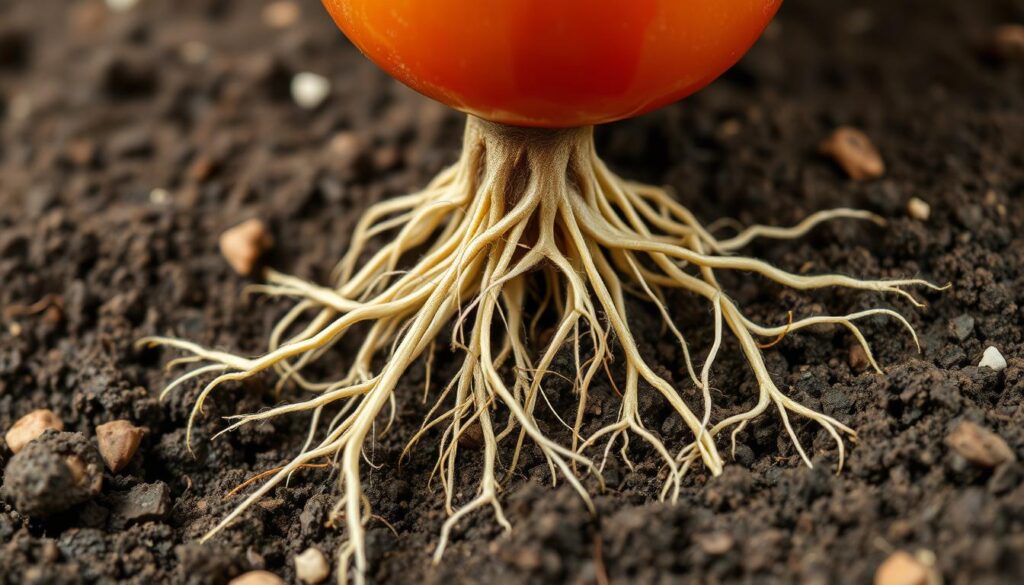
Corrective Measures
If your tomato plants are planted too deep, there are ways to fix it. These include:
- Adjusting the soil level around the plant to the right depth.
- Improving soil drainage by adding compost to prevent waterlogged soil.
- Providing support
for leggy plants to prevent them from breaking under fruit weight.
By taking these steps, you can help your tomato plants recover. This will improve their health and fruit production.
Regional Considerations for Tomato Planting Depth
When planting tomatoes, it’s important to think about your area’s climate and soil. The right depth can change a lot based on where you live and the soil you have.
In warmer places, tomatoes need to be planted deeper. This helps them grow strong roots. Strong roots are key for plants to thrive in hot weather.
Climate Impact on Root Development
The weather in your area affects how deep to plant tomatoes. In hot summers, deeper planting keeps roots cool. In cooler areas, planting shallower helps roots grow better.
Climate Considerations for Tomato Planting Depth
| Climate Type | Recommended Planting Depth | Rationale |
|---|---|---|
| Warm/Hot | Deeper (up to 2/3 of the stem) | Encourages deeper root growth, protecting against heat and drought |
| Cool/Temperate | Shallower (about 1/3 of the stem) | Prevents soil from being too cold, promoting root growth |
Seasonal Adjustments
Seasons also play a part in how deep to plant tomatoes. In places with cold winters, planting deeper in spring helps roots stay warm. This protects them from cold soil.
For instance, in short growing seasons, planting in a trench warms the soil around roots. This method involves starting seedlings in a shallow trench. As they grow, the trench is filled in.

Understanding these regional and seasonal tips helps you plant tomatoes the right way. This leads to healthier plants and a bigger harvest.
Conclusion: Making the Most of Your Tomato Planting Depth
Knowing how deep to plant tomato seeds and tomatoes is key to success. The right depth helps roots grow strong, plants stay healthy, and you get a big harvest.
Soil type, drainage, and climate affect how deep to plant tomatoes. By considering these and following our tips, you’ll have a great harvest.
With the correct depth and care, your tomatoes will thrive. Take the effort to do it right, and soon you’ll be enjoying fresh, homegrown tomatoes.
FAQ
How deep should I plant my tomato plants?
Plant tomatoes so half the plant is underground and half is above. For a 12-inch plant, bury 6 inches of stem.
How deep do tomato roots grow?
Tomato roots can reach 3 feet deep in good conditions. But, soil type, moisture, and temperature also play a role.
What is the recommended planting depth for tomato seeds?
Plant tomato seeds 1/4 inch deep and 2-3 inches apart. This helps them grow well.
How do I transplant established tomato plants to the correct depth?
You can bury the plant up to its first true leaves or lay it on its side in a trench. Then, cover it with soil.
What are the signs of improper planting depth, and how can I correct them?
Weak plants, yellow leaves, and soft stems are signs of wrong depth. To fix, adjust depth, improve drainage, or support the plants.
How does soil type affect the planting depth of tomatoes?
Soil type matters. Heavy clay needs organic matter for drainage, while sandy soils need more water.
What are the benefits of proper depth planning for tomato plants?
Right depth planning means strong roots, healthy plants, and lots of tomatoes. It also prevents weak plants, rot, and disease.
How does climate impact the optimal planting depth for tomatoes?
Climate and season affect planting depth. Warmer places need deeper planting, while cooler ones need shallower.